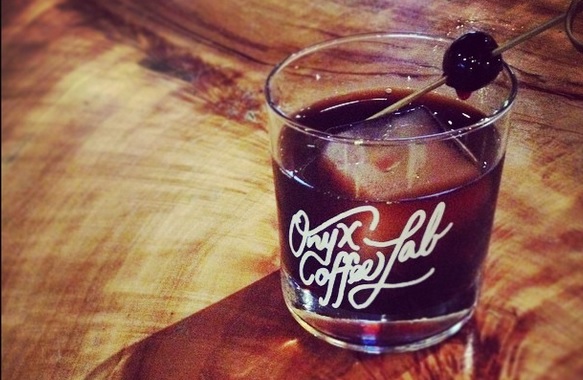In craft coffee shops and barista competitions across the US, there’s a compelling trend underway, as techniques commonly reserved for cocktails are making their way from bartender to barista.
“You’re really starting to see the influence of mixology in the craft coffee scene,” said Levi Andersen, host of the Audio Café Podcast. “Especially in competitions like the World Barista Championships, you’re really seeing a lot of competitors taking inspiration from the cocktail scene.”
From simpler techniques like flavored syrups to more advanced processes like infusions and barrel-aging, cocktail fans might start finding their local craft coffee shop is serving specialty drinks that have a lot in common with their spirited cousins behind the bar.
HOUSE-MADE SYRUPS
Cost-effective and relatively simple to execute, house-made syrups are becoming ubiquitous in bars and are starting to make their way into craft coffee shops as well. They’re a great way to make a coffee (and cocktails) a little more unique and specialized.
In the 2015 Big Western Barista competition, many of the competitors used specialty syrups in their signature drinks, from Nicholas Rodriguez’ lavender simple syrup to Brandon Paul Weaver’s Jack Fruit Syrup. This technique has become a regular feature in competitions, but it’s less common in coffee shops, where bottled syrups like Torani and DaVinci are still the norm. Yet a handful of specialty shops like Heartwork Coffee Bar in San Diego and Kansas City’s Parisi Café are offering house-made syrups in flavors like Vanilla and Salted Caramel.
INFUSIONS
In the bar scene, infusions are another popular way to introduce even more flavors to spirits and cocktails. And craft coffee shops are slowly following this path, too, inspired by the work of award-winning baristas like Nick Clark. In the 2013 Barista Semifinals, Clark impressed judges with infusions that called upon sweet nectarines, dehydrated raspberries, rose petals and cocoa nibs.
Further evidence of this trend is slowly creeping across coffee shop menus. For example, chickory-infused milk is served in a specialty drink at District Hand Pie & Coffee Bar in New Orleans, and you’ll find bacon infused milk on the menu at Vespr in Orlando.
CARBONATION
Since carbonation is usually limited to cold beverages, it’s not surprising that it hadn’t found a place in coffee drinks until cold coffee became more commonplace. Now that cold-brew coffee is a staple of craft coffee shops, bubbles have started to appear on specialty menus as well. Some craft coffee shops are starting to serve cold-brew coffee which has been either nitrogenated or carbonated, resulting in a sparkling final product not unlike some coffee-inspired beers.
Saint Frank Coffee in San Francisco gets their bubbles in a more traditional way: they serve a “Café Tonic” by adding a full bottle of Fever Tree Tonic Water to a fresh espresso shot for a drink that’s akin to a tall, effervescent cocktail.
But carbonated coffees aren’t limited to specialty craft coffee shops. The next time you’re in Starbucks, try ordering your iced coffee “carbonated.” Rumor has it they can use their soda carbonating equipment to carbonate most cold drinks on the menu.
Even beyond the coffee shop, you can find cold-brew carbonated Coffer in specialty grocery stores, and Cuvee Coffee’s popular nitro-charged cold-brew “Black and Blue” should be available in a can and coming to a grocery store near you sometime in 2015.
BARREL-AGING
Aging spirits in barrels is well established–and mixologists have been barrel-aging cocktails for a few years now. But in the world of craft coffee, barrel-aging is a technique that’s just getting started.
Inspired by barrel-aged Manhattans, Ceremony Coffee’s director Ronnie Haas started experimenting in 2012 with conditioning their green coffee beans in used whiskey and red wine barrels. Pleased with the result, Haas and other roasters like Whiskey Barrel Coffee have started to offer their barrel-conditioned beans to consumers. The resulting coffee varies, but it usually exhibits a slight vanilla and molasses sweetness that’s extracted from the barrel.
Taking barrel-aging in another direction, Onyx Coffee Lab in Arkansas has created a Coffee Old Fashioned (pictured) made with cold-brewed coffee, chocolate bitters and demerara syrup. The whole thing is aged in a bourbon barrel for three months, and the final product is served in a rocks glass. With its technique and presentation, it’s easy to mistake this coffee drink for a classic cocktail.
Whether it’s behind the bar or in the hands of a barista, a great drink is a great drink. When the best techniques get shared, the results are always better for the customer. And when great cocktail techniques find their way into the coffee shop, it means cocktail lovers can enjoy craft drinks in the morning as well.
Julia Tunstall is the co-creator of A Bar Above. Find her writing and recipes at A Bar Above.com or check out the Mixology Talk Podcast for cocktail tips, tricks and banter.





Nice work!
Thanks for the shoutout!
Hi Cigar Inspector – unfortunately not! Though I’ve had coffee using some of these techniques. Thankfully there are some good craft coffee places near where I live!
Fascinating article. Have you tried any of these drinks, out of curiosity?